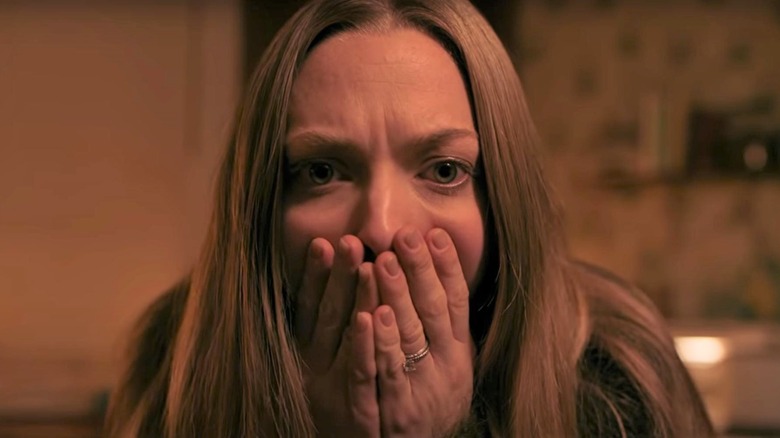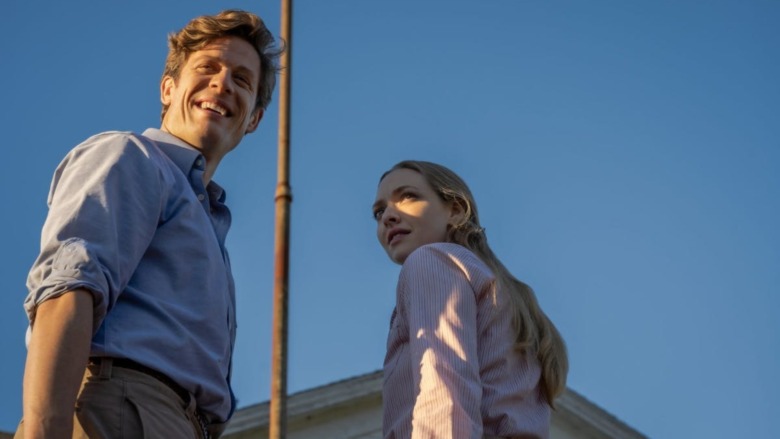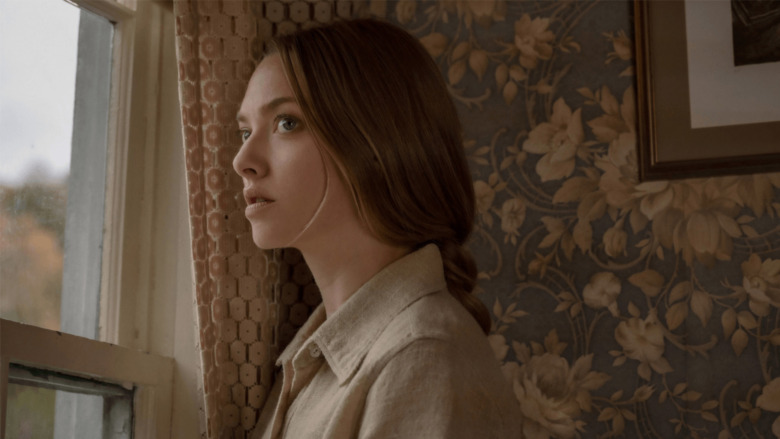Things Heard & Seen Review: You'll Wish You Hadn't
Sometimes a truly groundbreaking work of cinema can emerge from a director's attempt to adapt a novel considered "unfilmable." But more often than not, what makes the book so distinctive on the page proves impossible to translate to the big screen. There are considerably more noble failures of the "Cloud Atlas" or "High Rise" variety than there are innovative, experimental tomes that have successfully made the leap to another medium. And on the face of it, you'd be forgiven for assuming that "Things Heard & Seen" (streaming on Netflix from April 29) is a run-of-the-mill haunted house story and nothing more than a quick paycheck movie for everybody involved with the production. Instead, it's an adaptation of an acclaimed novel — an adaptation so loose that you probably won't recognize it even if you've read the book it's based on.
The significant changes to the source material may have been made to help translate a narrative that was otherwise impossible to tell on-screen, but in the process, they make for a film that forgets why this story is so distinctive on the page. The end result is a generic haunted house movie with only vague illusions to the far more complex character study in Elizabeth Brundage's novel "All Things Cease to Appear." Viewers unaware of the story's origins in a boundary-pushing, widely acclaimed book will be left baffled as to why the film's overqualified cast members are slumming it in an overlong, scare-free genre tale of the kind told countless times before.
An adaptation that gets lost in translation
As the 1970s end and a new decade begins, Manhattan-based couple Catherine (Amanda Seyfried) and George (James Norton) prepare to leave the city behind and move upstate. George has just bagged a job at a small private college teaching art history, leaving Catherine alone most of the day, painting and looking after their young daughter, Franny (Ana Sophia Heger). Not long after moving in, however, Catherine begins to notice apparitions, and she can't shake the sense that the house they've now made a home is hiding a darker history than initially meets the eye. It quickly becomes apparent that George has known about this history all along, and he struggles to hide the truth — something which proves impossible when the teenage descendants of the house's previous owners still regularly come by to do housework. But then, that's just one of many secrets that George is trying to keep to himself.
There's nothing wrong in making big changes to a story in the process of adapting it — cinema and literature are two different mediums, after all. But "Things Heard & Seen" oddly shuffles the entire narrative to be told in chronological order, whereas its source material opens with what constitutes the film's grisly conclusion and works backwards from there. The boldest choice Elizabeth Brundage made with the novel is refusing to use quotation marks. The story is told entirely from the blinkered perspective of George, who's so self-absorbed that he can only process the thoughts and feelings of others if they're filtered as his own. Arguably, the most notable change writer/directors Shari Springer Berman and Robert Pulcini make is not even attempting to replicate the story from this character's perspective. The biggest thing that renders the source material "unfilmable" is how it spends so much time in this character's headspace while attempting to remain ambiguous as to the full extent of his actions, something impossible in a medium reliant on the philosophy of "show, don't tell."
So, when reimagined as a mystery told from another character's perspective, it can't help but feel like something crucial has been lost in translation. Reviews of Brundage's novel championed the unique way she got inside the mind of a possible psychopath, while Berman and Pulcini keep him at something of a remove, with Norton's performance never subtle enough to hide his (and, to a greater extent, the story's) biggest secrets. He's as untrustworthy as he would appear on the page, but if that aspect is supposed to be hidden here — unlike in the brutal cold open to the novel — any attempt at crafting suspense can only fall flat. It doesn't help that, from the second they arrive upstate, he begins acting like Jack Torrance after spending weeks in the Overlook Hotel, a ticking time bomb the film takes too long to let properly explode.
Nothing but tropes
It doesn't help that Catherine's side of the narrative never evolves into anything beyond the usual mystery tropes of a haunted house thriller, checking off all the expected boxes as it goes through the motions. Viewers shouldn't be left feeling guilty if they keep fast-forwarding to the third act, where the hell you'd expect to break loose finally does.
Up until here, the film's best moments are when it deviates from its ghost story inclinations to become a darkly comic portrait of a man who's ruining his personal and professional life based on his own hubris. As a secret George was hiding from his new employer comes out in the open, I was left reminded of one of last year's most underrated films, Sean Durkin's "The Nest," another tale set in the 1980s about a man who forces his family to move with him for an ill-fated career opportunity. Although not a horror film, Durkin had a better handle on making the imposing, ghostly home the family moved into feel genuinely unnerving, as well as offering a more incisive study of a man intent on digging a deeper hole for himself with each bad decision. Of course, "Things Heard & Seen" is adapted from a novel about the interior workings of a would-be psychopath, and it's shorn of any of the satire that made "The Nest" such an unexpected gem. But even considering this, Durkin's film had a more substantial threat than a film billing itself as a horror story.
Directors Shari Springer Berman and Robert Pulcini aren't exactly the first names you'd pick to adapt such an ambitious novel. Now best known as directors for hire behind forgettable comedy-dramas like "Girl Most Likely" and "The Nanny Diaries," the pair first made a splash with their 2003 film "American Splendor," a comedy biopic/documentary that proved irresistible, adapting the graphic novels of artist Harvey Pekar while unravelling the creative inspiration behind his life's work. An adaptation of "All Things Cease to Appear" sounds like their most ambitious effort in the nearly two decades since that breakout effort ... and all they've brought to the table is a lackluster attempt at reconfiguring the tale into a generic story of hauntings and hidden secrets.
After two hours spent sitting through this uninspired horror adaptation, you'll wish you hadn't heard or seen any of it.


